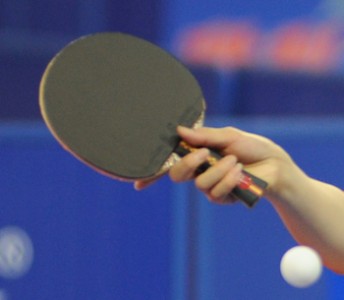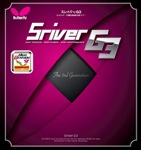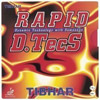L’importanza dell’impugnatura della racchetta
5 Dicembre 2011 da Ping Pong Italia · 7 Commenti
Eccomi, ci sono vivo e vegeto.
Qualche giorno fa ho rilasciato una specie di intervista e ne è venuto fuori un pezzo pubblicato sul portale pongistico americano Paddle Palace dal titolo “Perché la pressione sull’impugnatura è importante? Paddle Palace da oltre 40 anni è un distributore di materiale pongistico con sede a Portland (Oregon).
Ecco il pezzo in italiano e di seguito quello in inglese che comunque potete qui
Quando parliamo di impugnatura, il più delle volte riduciamo l’argomento ai vari tipi di impugnatura come a “stretta di mano” oppure a “penna’ includendo quella cinese, giapponese, coreana etc. Aggiungiamo, che con l’impugnatura a “stretta di mano” la si può preferire più aperta per favorire il diritto o più chiusa per favorire il rovescio.
Oltre a questi aspetti ce ne è uno che è molto importante al quale non si dà abbastanza attenzione. Si tratta della quantità di pressione che ogni giocatore esercita sul manico quando tiene la racchetta. Quando un tecnico lavora su un allievo, anche di grande esperienza, la pressione sull’impugnatura è qualcosa che dovrebbe essere considerata nel processo di sviluppo di quel giocatore, poiché la pressione cambia completamente i colpi e la tecnica del giocatore. Credo che molti errori siano dovuti appunto a questo. Per esempio, se un giocatore tiene l’impugnatura troppo stretta tanto da intesire i muscoli dell’avambraccio, i colpi risulteranno duri e privi di controllo.
Cosa significa quando si dice che un giocatore ha una gran tocco o sensibilità? Significa che il giocatore tiene la racchetta in tal modo da essere una parte della mano oppure si potrebbe dire che la racchetta è l’estensione del braccio-avambraccio-mano. Come responsabile tecnico dell’Indian Community Center, con una gran quantità di studenti, è importante per me capire cosa i ragazzi sentono quando colpiscono la palla. Chiedo loro, stringi abbastanza la racchetta? Non la stringi affatto? Perché la palla non va dove desideravi che andasse? Questo processo di domande e risposte comincia a dare qualche risultato, I giocatori ottengono una maggior comprensione di quello che succede, dell’effetto dell’impugnatura sui loro colpi. L’obiettivo è quello di capire meglio e apportare da loro stessi le modifiche durante il gioco, qualora fosse necessario.
Per esempio, se un giocatore ha dei problemi a tenere la palla corta perché stringe troppo la racchetta, gli dico che non è problema di come colpisce la palla ma di come stringe la racchetta. Se si impugna la racchetta troppo frote la palla rimbalzerà molto più perché incontra una superficie dura. Allo stesso modo, quando giocano colpo di scambio o un block o un topspin, si dovrebbe sapere quello che succede ed il ruolo che gioca appunto la stretta sul manico della racchetta per portare a segno il colpo.
Il pingpong è uno sport di esperienza. E l’esperienza è personale - ciò che il giocatore sente quando gioca è la sua esperienza, di nessun altro. Ma ci sono dei modi in cui l’allenatore può aiutare. Toccare l’avambraccio del giocatore dà all’allenatore un’idea di quale pressione si esercita con l’impugnatura. Se l’avambraccio è in tensione, i muscoli del braccio rigidi, il polso duro e la mano stretta, dunque sarà molto difficile per il giocatore avere un buon tocco di palla. Tuttavia, anche quando si colpisce in modo troppo duro, si può sviluppare una certa sensibilità poiché, come si è detto, questo è uno sport di esperienza e l’esperienza di gioco, nonostante le cattive abitudini, li aiuterà a trovare dei compromessi. Va detto, comunque, che sviluppare il giusto modo di impugnare produrrà un gioco più efficace.
 Incoraggio i miei studenti a rilassare la presa prima di colpire la palla e stringerla quando si colpisce la palla. La giusta impugnatura è di tenere la racchetta in modo rilassato ma fermo, senza stringerla troppo così da bloccare polso e avambraccio. Iniziare con una presa rilassata e stringere al momento di colpire la palla, né prima né dopo. Alcuni giocatori apprenderanno più velocemente di altri come impugnare correttamente. Ma prendendo coscienza della propria impugnatura (causa) e del colpo che ne segue (effetto), ogni giocatore sarà in grado di sviluppare la propria tecnica che deriva dalla sua impugnatura.
Incoraggio i miei studenti a rilassare la presa prima di colpire la palla e stringerla quando si colpisce la palla. La giusta impugnatura è di tenere la racchetta in modo rilassato ma fermo, senza stringerla troppo così da bloccare polso e avambraccio. Iniziare con una presa rilassata e stringere al momento di colpire la palla, né prima né dopo. Alcuni giocatori apprenderanno più velocemente di altri come impugnare correttamente. Ma prendendo coscienza della propria impugnatura (causa) e del colpo che ne segue (effetto), ogni giocatore sarà in grado di sviluppare la propria tecnica che deriva dalla sua impugnatura.
Alcuni giocatori mi dicono che non controllano la palla quando bloccano e posso vedere che l’impugnatura è rigida o morbida. Spiego loro che quando si colpisce una palla verso un muro la stessa ritorna abbastanza velocemente. Quando la si colpisce verso una transenna tutta la potenza verrà assorbita. La stessa cosa succede con l’impugnatura. Dipende dalla pressione che si esercita sulla racchetta, la mano e la racchetta possono assorbire la forza della palla o generare potenza. La pressione sull’impugnatura influenza anche la reazione alla rotazione che si riceve.  Sviluppare la capacità di regolare la propria impugnatura è una combinazione di tecnica ed esperienza. Più si capisce quanto l’impugnatura influenzi il colpo, più si avrà sensibilità ed esperienza per apportare aggiustamenti al gioco.
Sviluppare la capacità di regolare la propria impugnatura è una combinazione di tecnica ed esperienza. Più si capisce quanto l’impugnatura influenzi il colpo, più si avrà sensibilità ed esperienza per apportare aggiustamenti al gioco.
Quando alleno gli studenti, provo ad insegnare in 3 modi diversi: il primo è quello di spiegare la lezione verbalmente e vedo i risultati. Il secondo è quello di mostrare e dimostrare agli studenti quello che voglio che facciano. Se questo a volte non basta allora provo il terzo, quello cinestetico. Tengo il loro braccio e giochiamo insieme. Gli studenti sono tutti diversi e apprendono in modo diverso quindi utilizzo uno di questi modi e osservo i positivi risultati.
Why is Grip Pressure So Important?
By Max Costantini
When we talk about grip, most of the time we reduce the topic to the types of grips such as shakehand or penhold, including Chinese, Japanese, Korean and so on. We add, for example, that with the shakehand grip you can keep your grip for the forehand and the backhand a bit open or a bit closed.
But beyond these things there is another aspect of the grip that is very important but does not get enough attention. This is the amount of pressure each player applies to his or her handle when holding the paddle. When a coach works with a student, even a very experienced one, the player’s grip pressure is something that should be considered in that player’s developmental process, as grip pressure changes a player’s strokes and technique completely. I believe many mistakes happen because of grip pressure. For example, if a player holds the paddle so tight that all the muscles in their forearm are tense, then the ball is going to be played very hard with a lack of control.
When a player is said to have great touch, what does that mean? Great touch means that a player holds the paddle in such a way that the paddle is the same as their hand, or you can say the paddle is an extension of his/her hand. As the coach at ICC, with a lot of different students, it is important for me to understand what they are feeling when they hit the ball. I ask them, are you squeezing the paddle enough? Do you squeeze the paddle at all? Why is the ball not going where you want it to go? This question and answer process regarding grip pressure is starting to get some results. Players are gaining more understanding of what is going on with their grip pressure and how it affects their shots. The goal is to understand it well enough to make adjustments, when required, on their own.
For example, if a player is having trouble keeping the ball short because they squeeze too hard, I tell them it’s not a matter of how to hit the ball, but it is a matter of how to hold your paddle. If you hold the paddle with too much pressure the ball will automatically bounce too hard off the paddle surface. Similarly, when they drive or block or execute a loop, they should know what is going on with their grip pressure and the role it plays in producing a successful shot.
Table tennis is a sport based on experience. And experience is personal–what a player feels when playing is his/her own experience. But there are ways a coach can help. Touching the player’s forearm gives the coach an idea of how much pressure the player is using to grip the paddle. If the forearm is tense, the arm muscles hard, the wrist stiff and the hand tight, then it will be very difficult for that player to have good touch. However, even when a player hits with too much pressure he/she can still develop a kind of feeling because, as I’ve said, this is a sport of experience and a player’s experience, despite bad habits, will help them adjust. However, developing the appropriate amount of grip pressure will result in a more effective game.
I encourage my students to relax their grip enough so they can feel the paddle and then squeeze when they hit the ball. The right grip is to keep the paddle relaxed, to keep firm, but not to squeeze enough to produce tension in the wrist or forearm. Start with a relaxed grip and squeeze just as you strike the ball, not before or after. Some players will learn more quickly than others the correct grip pressure and when to squeeze. But by becoming aware of grip pressure and its effect on hitting the ball, each player will be able to work on developing their own grip technique.
Some players tell me their block is out of control, and I can see that their grip is too loose or too hard. I explain to them that when you hit a ball off of a wall it returns quite fast. When you hit a ball into a barrier all of its power is absorbed. The same thing happens with your grip. Depending on the grip pressure, the hand and paddle can absorb the ball’s force or generate power. Grip pressure also dictates a response to the spin you are receiving. Developing the player’s ability to adjust their grip is a blend of technique and experience. The more they understand how the grip affects a shot, the more they will feel and experience and the better they will be able to adjust.
When I coach my students, I try to teach in three ways. The first way is to explain the lesson I’m teaching verbally and then to watch the results. The second is to show or demonstrate to the student what I want them to do. Sometimes this is not enough so the third way I teach is the kinesthetic way. I hold their arm and we play together. Students are all different and learn in different ways so I will use any and all of these methods and watch for positive results.

